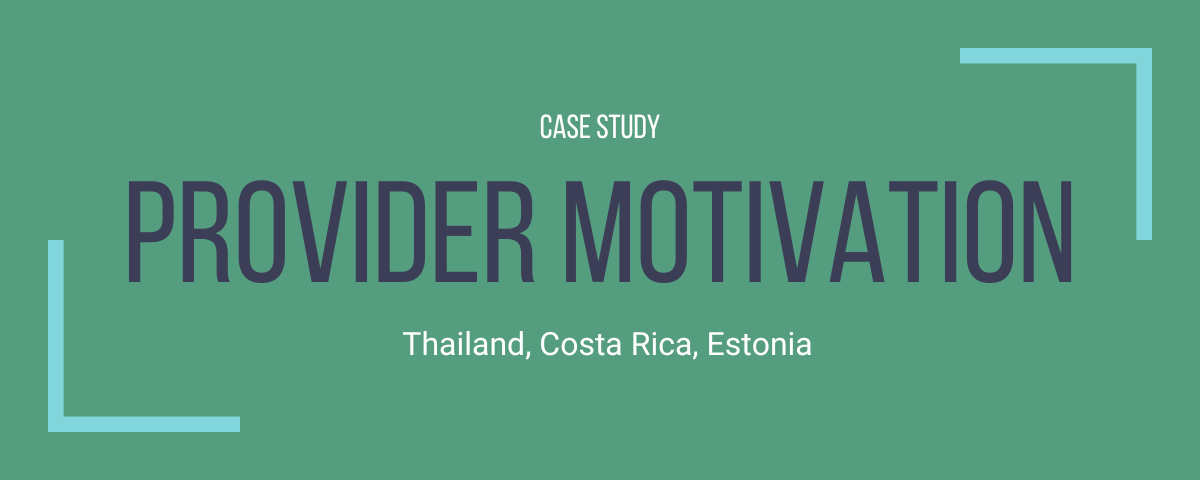Over the last several decades, performance-based financing (PBF) has been used to motivate health workers and improve the quality of care. However, PBF can be integrated into provider payment mechanisms in a variety of ways, and the success of each is contingent upon local context. While there are observed challenges associated with PBF, the case studies below focus on relatively successful interventions of PBF that also highlight the complexities of measure selection.
Thailand implemented PBF for primary care providers in 2013 using the UK Quality and Outcomes Framework.1 The PBF program is supplemental to capitated payments which are the primary method of provider payment in Thailand. Thailand’s program was designed to incentivize the provision of health promotion and disease prevention, primary care services, organizational development and management, and services targeted to local needs. In pursuit of this latter goal, the indicators that providers are evaluated against differ between regions in order to address local health problems and facilitate decentralized decision-making power. Program implementation was challenging due to a number of factors. Most importantly, the program was not piloted prior to widespread implementation, and although policy-makers did anticipate challenges due to the health system differences between Thailand and the UK, they planned to adapt the program during implementation. Additionally, while local indicators were needed to develop the program, dissemination of details related to the program was poorly timed, resulting in a delay in initial implementation. Finally, the information systems were not reliable to perform the tasks necessary for successful implementation of the PBF program.
Following the initial implementation of this program and feedback that the indicators had poor validity, the quality indicators were adapted through collaboration with the National Institute of Health and Care Excellence. Extensive indicator development and testing plans were developed.2 Through this process, implementers were able to evaluate the validity and reliability of the indicators in practice and adapt as necessary. Details on the process can be found in this paper. To our knowledge, there has yet to be an evaluation of the implementation of these revised indicators.
Costa Rica has achieved remarkable population health outcomes due to a strong focus on and commitment to primary health care and community-based services since the early 1990s.3 In 1996, Costa Rica instituted a version of PBF, called management commitments. In this model, the Costa Rican social security agency – the Coja Costarricense de Seguro Social (CCSS) – and service providers agree to performance indicators and targets on an annual basis. However, an early evaluation of this program found mixed results. Not only were the monetary incentives insufficient, but providers felt that the achievement of targets detracted from their work and sometimes prevented them from providing people-centered, comprehensive, and compassionate care.4 Often, indicators and targets measured activities and performance rather than outcomes, leaving providers little freedom to provide care tailored to specific patients’ needs. The management commitment process has since been reformed; indicators and targets are now instead centered on outcomes and system improvements.3 This new process has enabled providers to focus more on preventive care and proactive health needs.
Provider payment in Estonia includes a mix of monthly allowances, fee-for-service, and PBF through the Quality Bonus System (QBS). The QBS was introduced in 2006 and became mandatory for all family physicians in 2016. In this model, providers earn points based on annually revised indicators related to disease prevention, chronic disease management, and other activities.5 However, like Costa Rica, the performance indicators incentivized providers to prioritize specific services rather than focus on more holistic, comprehensive care.6 Despite this, there is evidence of improvement in most of the indicators measured through the QBS. However, improvement cannot be entirely attributed to QBS because it was implemented concomitantly with other primary health care strengthening strategies such as organizational reforms, strengthened workforce, and improved information systems.7
In these geographically diverse cases, the indicators and targets initially chosen for PBF schemes limited providers’ autonomy and ability to practice person-centered care.136 Revision of indicators to instead measure outcomes has been shown to improve provider acceptability.4 However, the success of these schemes is also dependent upon robust capacity and infrastructure to measure performance and monitor programs. PBF is discussed here as an example of a payment scheme that can affect provider motivation; it will also be discussed in the Health Financing module. To our knowledge, PBF is the most empirically researched of the various monetary external motivation strategies. However, there are many others including pensions, insurance, travel, child care, rural location, heat and retention allowance; and subsidized meals, clothing, and accommodation.8

